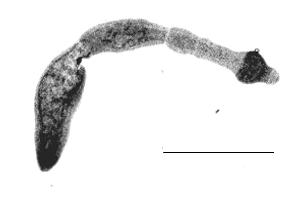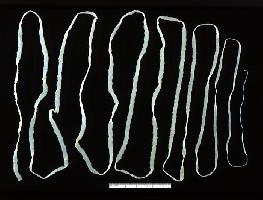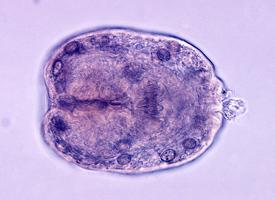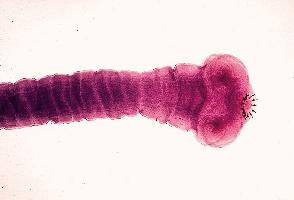
Váhy a míry
| Délka | od 2 do 5 mm |
|---|
Stav ohrožení
| Neohrožen |
Popis zvířete
The Fox tapeworm, scientifically known as Echinococcus multilocularis, is a parasitic worm that primarily belongs to the class Cestoda within the phylum Platyhelminthes. This organism is notorious for causing a severe and potentially lethal disease known as alveolar echinococcosis (AE) in various intermediate hosts, including humans. The life cycle of Echinococcus multilocularis is intricate, involving definitive hosts, typically foxes and other wild canids, and intermediate hosts, mainly rodents and accidentally humans.In its adult stage, the fox tapeworm resides in the small intestine of the definitive hosts. It is a small tapeworm, usually measuring 1.4 to 3.7 mm in length, consisting of a scolex (head) equipped with suckers and hooks for attachment, followed by a short neck and three to five proglottids (body segments). The last segment is gravid and contains eggs that are released into the environment through the feces of the infected animal.
When the eggs are ingested by an intermediate host, they hatch in the intestine, releasing oncospheres that penetrate the intestinal wall and travel through the bloodstream to various organs, predominantly the liver. Here, they develop into larval stages known as metacestodes, which form a mass resembling a tumor. This mass is characterized by numerous vesicles that proliferate extensively, invading the surrounding tissues and occasionally spreading to other parts of the body, such as the lungs and brain.
In humans, the infection is acquired through the accidental ingestion of E. multilocularis eggs, which can occur through handling contaminated soil, vegetation, or consuming food and water contaminated with feces from infected animals. The progression of alveolar echinococcosis in humans is slow and can take years before symptoms manifest, making early diagnosis challenging. Symptoms are often severe and can include abdominal pain, weight loss, and jaundice, reflecting the extensive damage to the liver and potentially other organs.
The management of alveolar echinococcosis involves complex medical and surgical interventions, including antiparasitic drugs and, in some cases, liver transplantation. Prevention strategies focus on reducing the risk of transmission by avoiding direct contact with definitive hosts and their feces, washing hands and food thoroughly, and controlling rodent populations.
The distribution of Echinococcus multilocularis is primarily in the northern hemisphere, including parts of Europe, Asia, and North America. The expansion of its range is a growing concern, attributed to changes in wildlife populations, human behaviors, and possibly climate change, making it a subject of ongoing research and public health efforts.
In summary, the fox tapeworm, Echinococcus multilocularis, is a small but formidable parasite that poses significant health risks to humans and animals. Its complex life cycle, involving definitive and intermediate hosts, underscores the challenges in controlling this zoonotic disease and highlights the importance of interdisciplinary approaches to understand and mitigate its impact on public health and wildlife conservation.
Podobná zvířata
Nové fotografie zvířat
Top 10 zvířat
- Chinese water dragon (Physignathus cocincinus)
- Galápagos tortoise (Geochelone nigra complex)
- Dolphin gull (Leucophaeus scoresbii)
- Japanese macaque (Macaca fuscata)
- Colombian red howler (Alouatta seniculus)
- Sea urchins (Echinoidea)
- Diana monkey (Cercopithecus diana)
- Moustached guenon (Cercopithecus cephus)
- Common reed warbler (Acrocephalus scirpaceus)
- Common house mosquito (Culex pipiens)


